
Growing Sweet Potatoes: Planting, Care And Harvest
Sweet potatoes may be the first choice for farmers looking for an unfussy, profitable crop to grow. You can grow sweet potatoes in many climates with just a few straightforward techniques. The vegetables’ extended storage life is a bonus for commercial farmers.
By enabling the proper application of fertilizers and irrigation, as well as the monitoring of field conditions throughout the growing season, modern precision farming technologies open up new levels of crop quality and quantity. Let’s dig deeper into key considerations like ideal sweet potato growing conditions along with proper planting, cultivation, and harvesting techniques to help you ensure you reap an abundant yield.
When And Where To Grow Sweet Potatoes
Warm climates with consistent rainfall, particularly tropical, allow to grow the crop all year round. As the crop can’t endure frost, farmers in colder regions grow short-season sweet potato varieties that yield in three to four months.
Sweet potato is a staple food in Central and South America, the Caribbean, Africa, and Japan. In the United States, North Carolina, California, Mississippi, and Louisiana are the states that grow the most sweet potatoes.
Favorable Growing Conditions For Sweet Potatoes
Sweet potatoes are root vegetables that require little care and tend to grow as a creeping vine. The crop thrives in warm, humid growing conditions with temperatures not higher than 85–95°F (29–35°C). Temperatures above 100°F (38°C) may cause sweet potatoes to grow more slowly, but they are typically harmless given sufficient irrigation and nighttime temperatures below 80°F (27°C). For optimal crop development, it is also necessary to expose the plants to full sunlight for six to eight hours every day during the growing season.
The ideal soil for commercially growing sweet potatoes is permeable, slightly acidic to neutral (pH 6.0–6.5), and high in nutrients and organic matter. Despite this, the crop will grow normally in nearly any soil type.
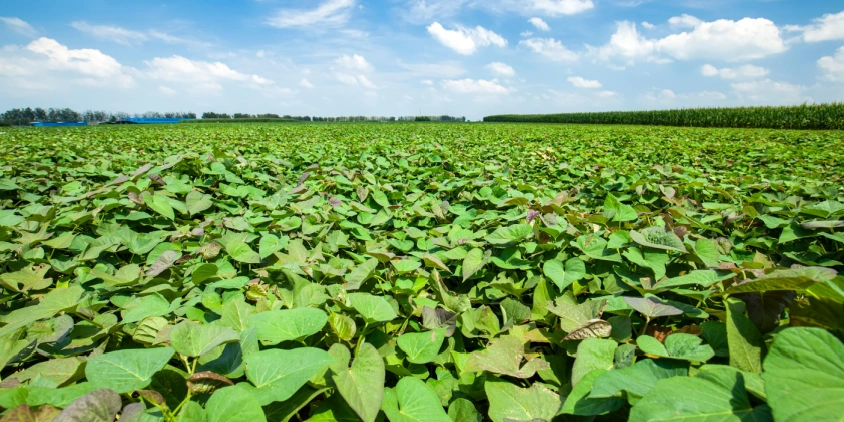
Sweet Potato Pre-Planting And Planting Procedures
You need to get the soil ready before you can plant sweet potatoes. For proper planting and growing, this heat-loving crop requires warm soil and frost-free conditions. Give every plant enough room to grow and reach the water and nutrients it needs.
Preparing The Soil For Planting
Preparing the soil for the sweet potato planting season should begin one to two months beforehand. To begin, either remove or incorporate crop residues and plow the field. After the soil has been allowed to settle for a few days and is at the perfect moisture level, till the land. It is crucial to till the soil finely and eliminate big lumps to let the crops enroot. Consider using a pre-emergence herbicide if the field has a persistent weed problem, such as perennial weeds.
Coir (a growing medium made of coconut fiber) may be a helpful amendment to soils that are poor at retaining water. For growing sweet potatoes in compact or heavy clay soils, construct raised beds or mounds 10–12 inches (25–30 cm) high. To increase the pH level and calcium (Ca) content of the soil, add lime or dolomite.
The next crucial step before growing sweet potatoes is soil solarization or organic mulching. This is especially relevant in growing regions with suboptimal soil temperatures during planting. The mentioned techniques help warm up the soil in the root zone to optimal ranges of 70–80°F (21–27°C) and prevent weeds from growing, which allows for early planting.
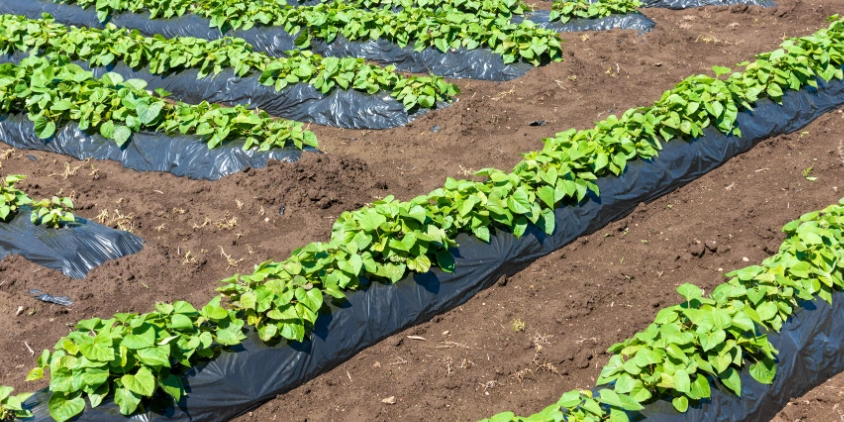
Planting Sweet Potato Slips
Slips (root sprouts), best suited for planting sweet potatoes, can be purchased or cut from the previous year’s tubers. Slips grow in seedbeds for about a month or two before they are ready for transplanting. Although larger cuttings may result in greater yields, farmers typically prefer growing from slips that are 8–10 inches (20–25 cm) in length and have 5-8 nodes and enough leaves for transplanting.
Space 6-inch (15 cm) planting holes no less than 12 inches (30 cm) apart and rows 36 inches (91 cm) apart to prevent competition between growing plants and allow enough room for field operations. After burying the slips in the holes up to the upper leaves, lightly press the dirt down and water thoroughly.
To give crops enough time to grow while protecting them from killing frost in the spring, plant after the soil warms up and the last frost has gone. In growing regions where the soil doesn’t freeze, plant at a soil temperature of 65°F (18°C) or higher. During the night, the air temperature shouldn’t drop below 55°F (13°C).
To choose the best area and time for growing sweet potatoes, consult EOSDA Crop Monitoring. We have daily and cumulative temperature records going all the way back to 1979, so you can see weather patterns and use this data to find out the best period for planting.
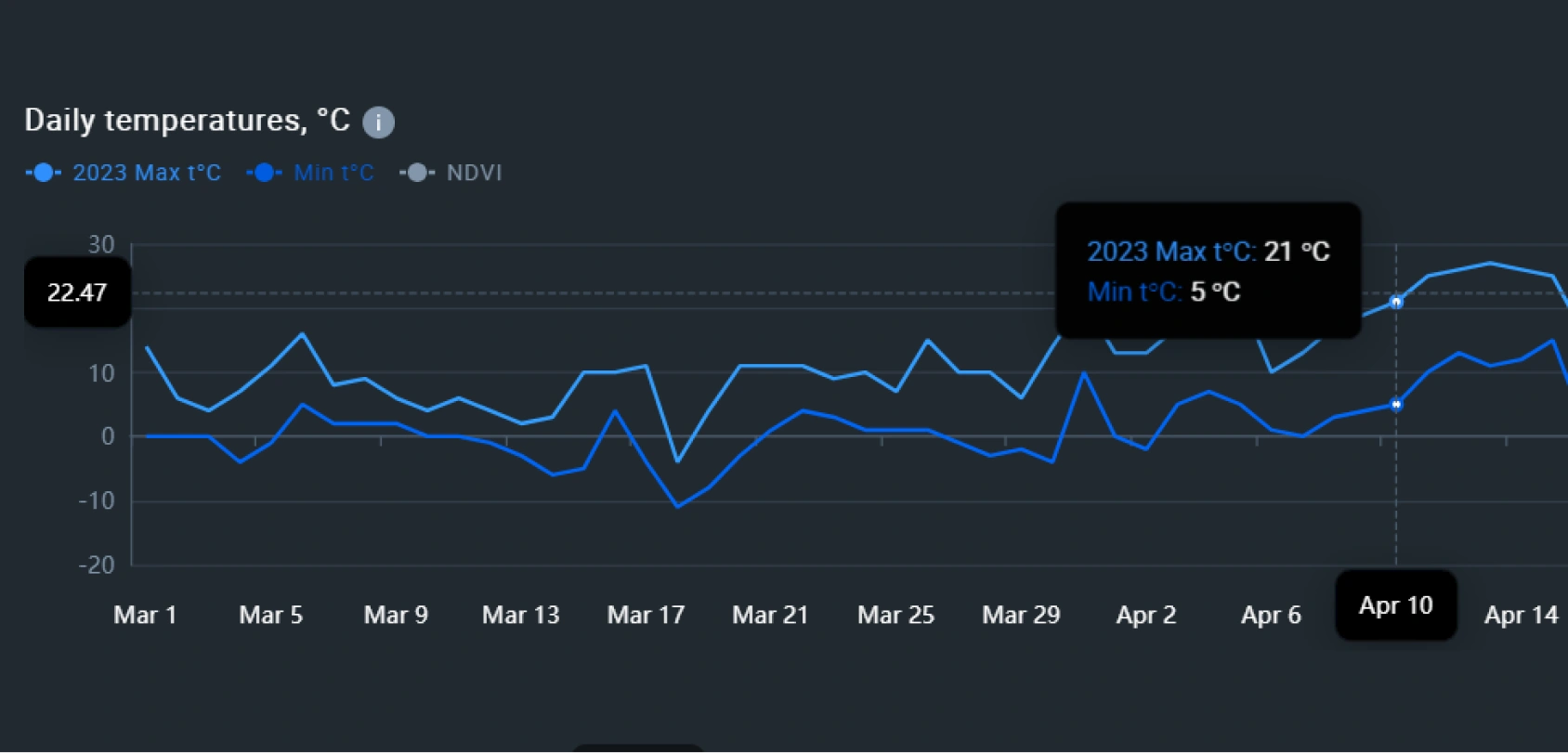
Care And Maintenance Of Sweet Potatoes
Most tasks involved in caring for sweet potatoes are common to all crops: watering, fertilizing, and controlling pests and diseases. Mulching and pruning excessively long vines are more specific to the crop.
Sparing Watering
During periods of dry weather, water the soil 1 inch (2.5 cm) per week. To prevent tuber rot, avoid overwatering the crop; after enrooting, it will grow well even in dry spells . Also, excess moisture at the end of the sweet potato growing season, especially in the last two weeks, can cause the vegetables to swell and subsequently crack during storage. Therefore, it is better to cease watering last month before harvesting.
Take advantage of the precipitation forecasts when planning sweet potato irrigation. Check out hyperlocal forecasts from precision agriculture platforms like EOSDA Crop Monitoring instead of relying solely on open data sources. Our platform provides comprehensive weather forecasts specifically for your fields. In addition to precise hourly precipitation data for a 14-day period, these forecasts incorporate a wide range of agriculturally relevant metrics, such as minimum and maximum temperatures, wind speed, solar radiation, evapotranspiration, and more.
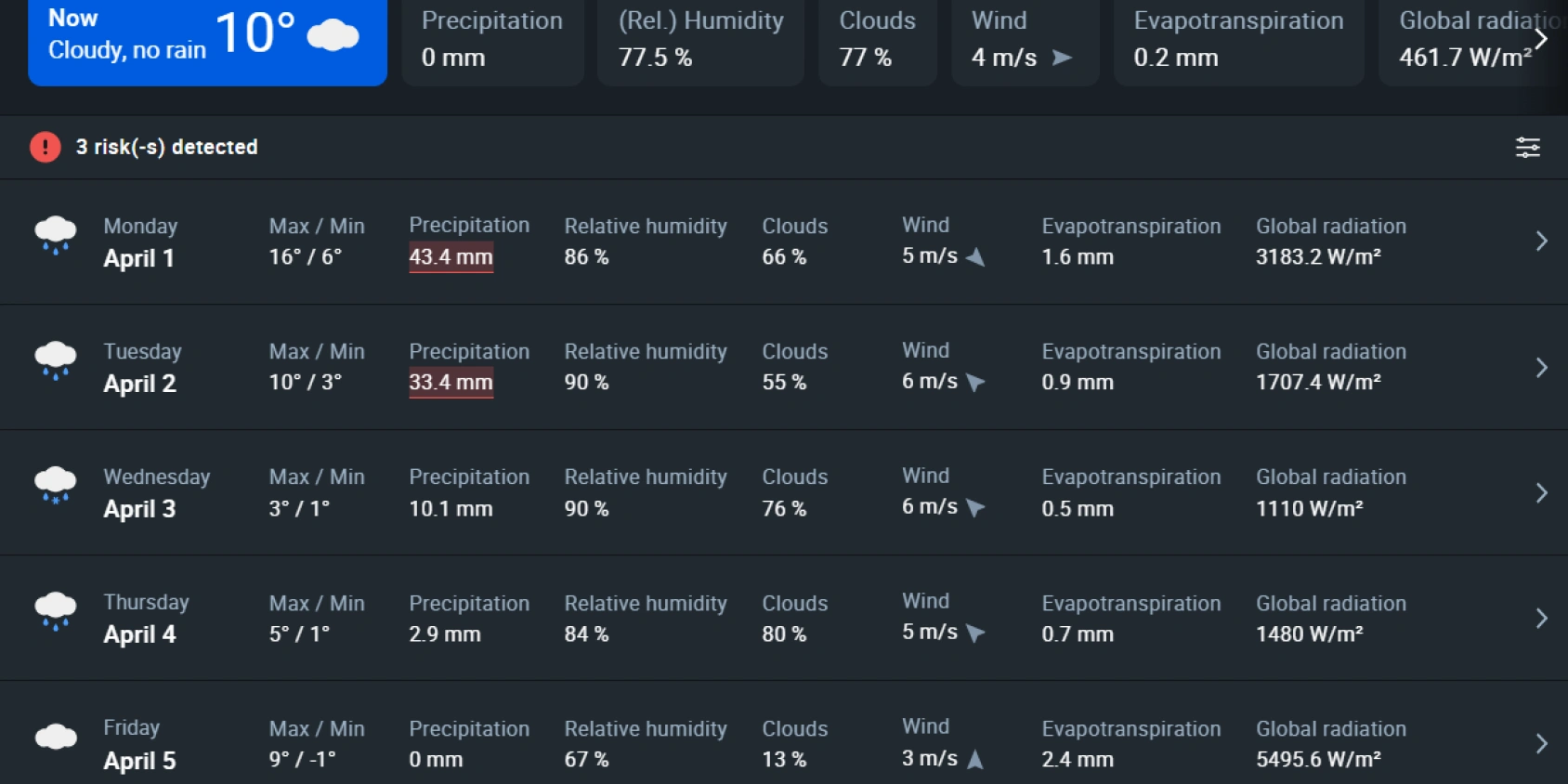
Careful Fertilizing
Even though sweet potatoes can grow in low-nutrient areas, most commercial farmers use fertilizers to increase yields. Usually, growers amend the rows with aged manure about two months before planting. Applying inorganic fertilizer two weeks before planting is a supplementary or alternative measure.
It is common to use a fertilizer with an NPK ratio of 5-10-10 for basal fertilizing at the beginning of the growing season. Farmers prefer to follow the next application scheme: all of the phosphorus, half of the nitrogen, and a quarter of the potassium needed. Later in the growing season, two side dressings are applied to spread the remaining potassium and nitrogen: once four to six weeks after planting, and again six weeks after the previous application. Excessive nitrogen fertilizing of sweet potatoes stunts storage root development in favor of branch and leaf growth, so moderation is essential.
When determining the amount of nitrogen fertilizer to apply, refer to the vegetation maps in EOSDA Crop Monitoring. Using satellite data and our in-built algorithms to analyze your fields’ vegetation, these maps will give you a good idea of how productive certain parts of the field can be. With this data in hand, you can adjust the nitrogen application rate to suit the situation in your fields. In areas with lower vegetation, where sweet potato growth may be affected by nutrient deficiency, a higher rate of nitrogen can be applied. Conversely, in areas with abundant vegetation, fertilize sweet potatoes with less nitrogen to prevent nutrient excess.
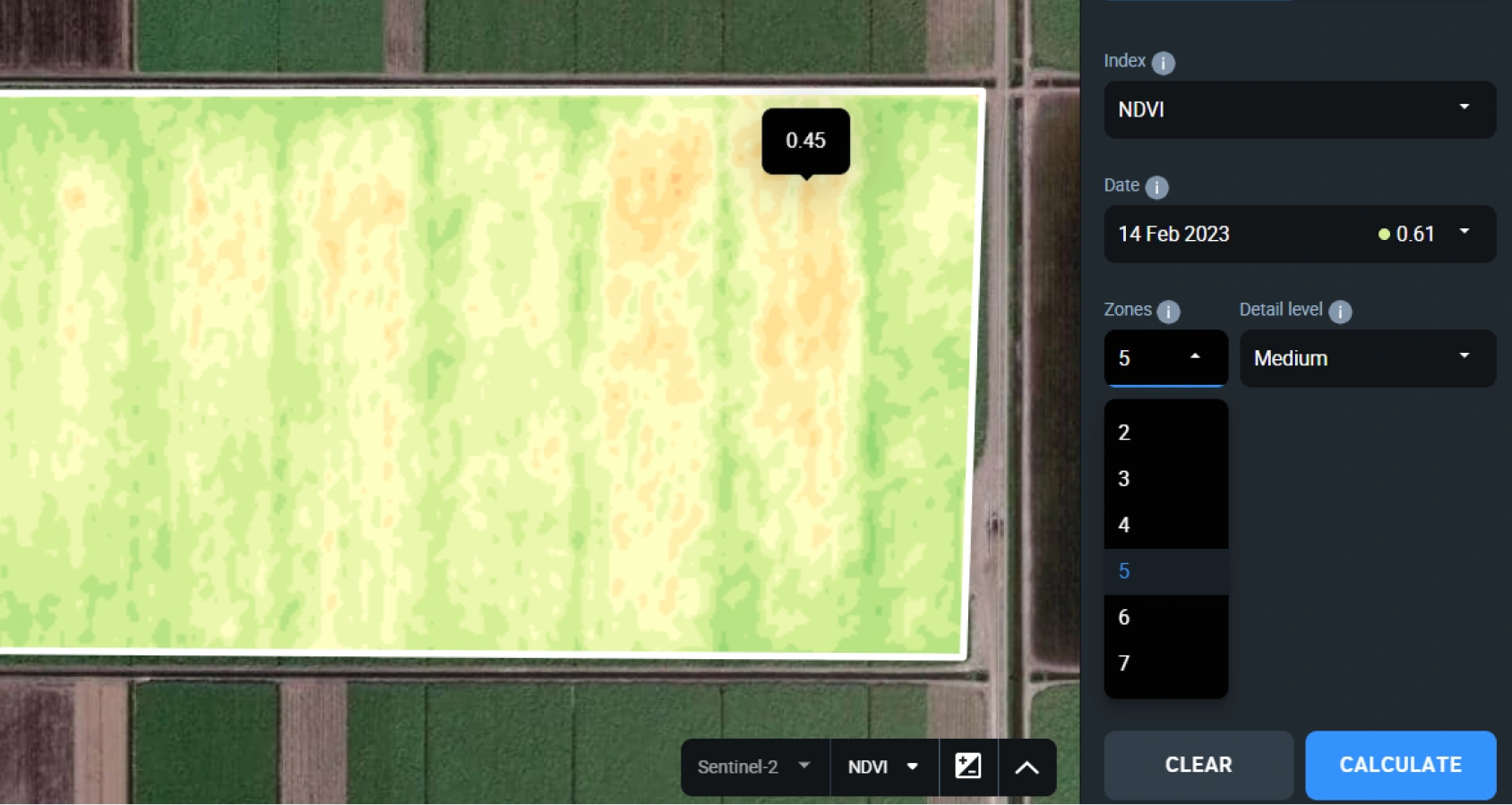
Managing Pests And Diseases
Despite the sweet potato’s tolerance for challenging growing conditions, even with chemical treatment, pests and diseases can sometimes affect crop production. Growing resistant plant varieties is the first line of defense. Then, integrated pest management (IPM) arrives, helping farmers protect crops and boost yields while decreasing reliance on costly and harmful chemicals.
| Pest/Disease | Symptoms |
|---|---|
| Flea beetles |
|
| Fusarium wilt (stem rot) |
|
| Sweet potato scurf |
|
| White rust |
|
| Whiteflies |
|
Our satellite-based solution, EOSDA Crop Monitoring, allows remote field observation to identify pest and disease risks before they cause serious damage. You can get a sense of the field’s vegetation from processed satellite images and find anomalies in crop development using vegetation indices on our platform. Then, from this same platform, assign a scout to conduct further research into the areas where anomalies were detected. Finally, get all scout reports and photos in one place for easy access.
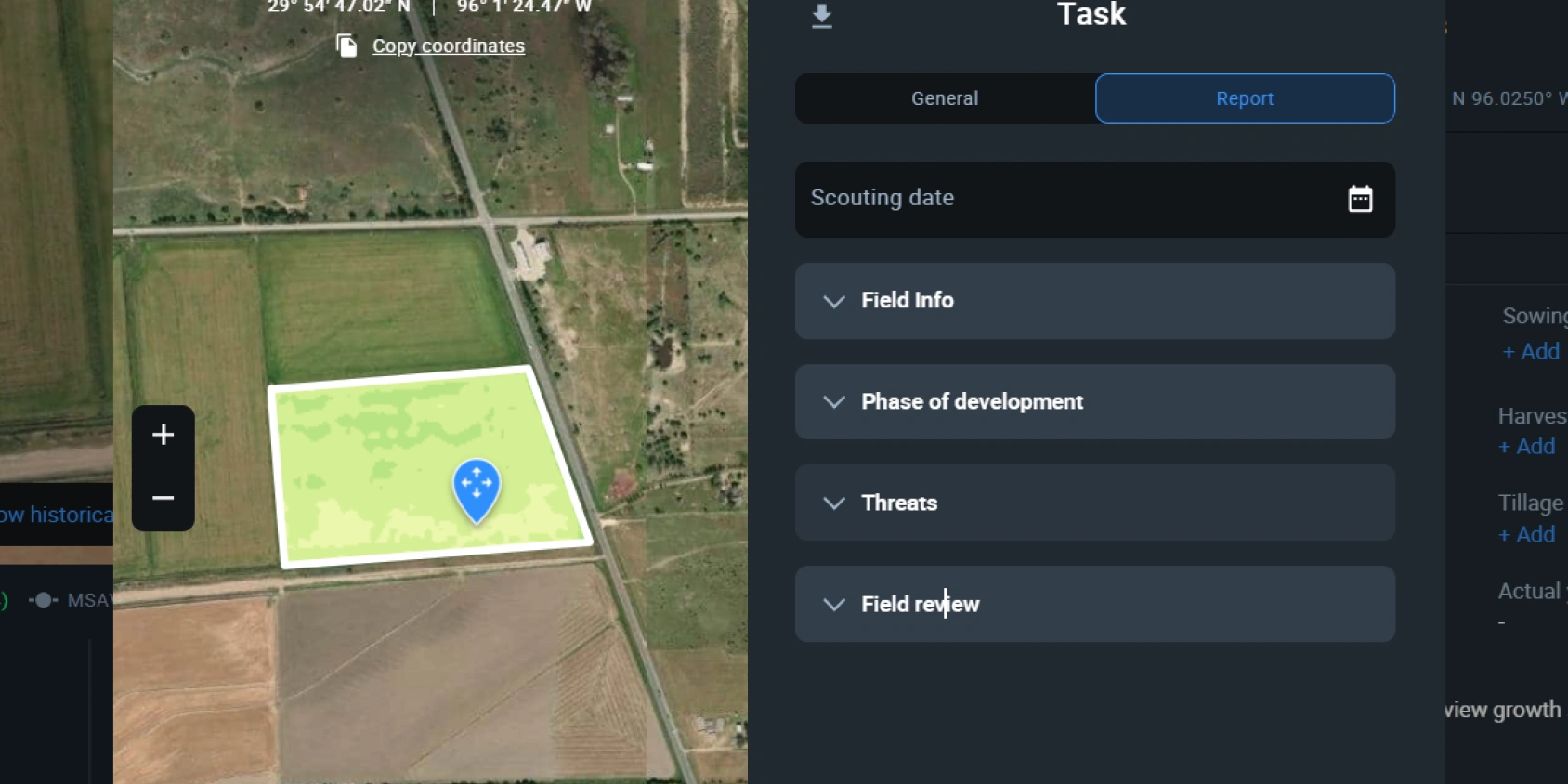
Organic Mulching
To prevent soil compaction and conserve moisture, use organic mulch two weeks following sweet potato planting (if the soil isn’t covered with plastic). In growing regions where weeds pose a problem, using organic mulch can be especially helpful. Mulching also raises soil organic matter levels, which in turn boosts crop yield components .
EOSDA Crop Monitoring
Fields monitoring platform, leveraging high-resolution satellite images to identify and react to any changes remotely!
Pruning And Supporting Plants
Although growing sweet potato plants typically do not require pruning, you may need to cut back vigorous stems if they begin to outgrow their designated area. These vine plants can be trained to grow on vertical supporting structures around 6 feet (1.8 m) in height, which is perfect for areas with limited growing space. Long vines can root at the joints and grow a plethora of undersized tubers all around the rooted vines unless you lift them periodically.
How Long Do Sweet Potatoes Take To Grow?
The amount of water in the soil at the beginning of the growing season and the variety of sweet potatoes are the main factors that determine how long the plant will grow. The typical time for sweet potatoes to grow ranges from 90 to 150 days. Some varieties, like Jewel and Stokes, take 120 days to grow, while others, like Beauregard and Georgia Jet, take only 90.
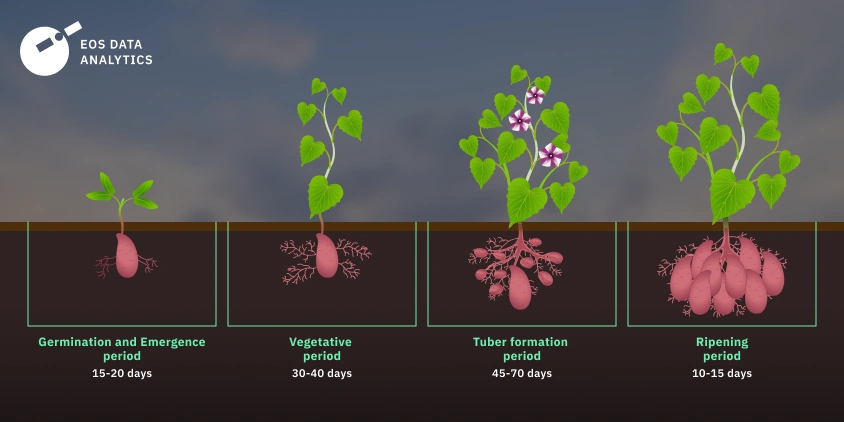
Harvesting And Storing Sweet Potatoes
Harvesting sweet potatoes at the optimal time and with maximum care allows for the highest possible yield. Curing is an additional step the tubers must undergo after harvest to prolong their storage life.
When To Harvest Sweet Potatoes
In most cases, around four or five months after planting, sweet potatoes are mature enough for harvesting. Tubers acquire the greatest weight, size, and nutritional value at the end of the growing season. So don’t rush the sweet potato harvest, even when the leaves have started yellowing. However, don’t put off harvesting for too long; tubers can rot rapidly after frost decimates the vines. What’s the prime harvesting time, then? When temperatures drop in the fall and vines begin to wilt.
How To Harvest Sweet Potatoes
The tubers of sweet potatoes are particularly delicate, so it’s necessary to harvest them when the soil is sufficiently loose and wet (adding organic matter helps with this). The first step is to dig up or remove the vine, being careful not to damage the tubers. The vegetables are then dug out of the ground using either flip plows or a digger chain attached to a tractor-drawn platform, or in cases of industrial-scale crop production, mechanical harvesters.
Next, field workers gather and sort the tubers. Harvesters equipped with special rollers, which sort the tubers by size and drop them into the appropriate boxes, sometimes mechanize this process.
Optimize your sweet potato harvesting process with our custom harvest monitoring solution for industrial-scale crop producers. Regular updates on estimated yield, harvesting dates for each particular field, and customizable reports with detailed crop data allow for enhanced harvesting productivity and efficiency.
Curing Sweet Potatoes After Harvest
Curing helps heal harvest wounds faster and keeps the tubers from spoiling when stored. For curing, keep the tubers at a temperature of 80–85°F (27–29°C) and a relative humidity of 85–90 percent for approximately 10 days. If you can’t get such conditions, extend the period to 14–21 days at a lower temperature of 65–75°F (18–24°C).
Store the cured tubers in a dark, cool place, maintaining a temperature range of 55–60°F (13–15°C). Fans that disperse air evenly and vents that ensure optimal oxygen levels are mandatory for storage and curing facilities. By following those guidelines for growing, harvesting, and storing sweet potatoes, you can produce a crop of superior and long-lasting quality.
About the author:
Vasyl Cherlinka is a Doctor of Biosciences specializing in pedology (soil science), with 30 years of experience in the field. He attended the engineering college in Ukraine and received his degree in agrochemistry, agronomy and soil science in the Chernivtsi National University. Since 2018, Dr. Cherlinka has been advising EOSDA on problems in soil science, agronomy, and agrochemistry.
Recent articles

Analyze 2025 & Plan Your Best Year Yet: LandViewer Christmas Offer
It’s the most wonderful time of the year! The Christmas holidays are here, and so is your chance to analyze 2025 and plan a prosperous 2026 with more affordable Pro plans in LandViewer.

EOSDA Models Climate Change Impact On Sugarcane Yields
EOSDA modeled future temperature, rainfall, and other climate impacts on Veracruz sugarcane. The results help growers plan long-term adaptation strategies, including timing, varieties, and irrigation.

EOSDA LandViewer Black Friday Sale: Exclusive Offers & Giveaway
This Black Friday, LandViewer offers new users the chance to save on monthly plans, get extra months with yearly subscriptions, and participate in a free annual plan giveaway.